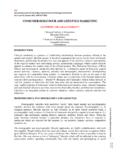Transcription of The digitisation of everything - ey.com
1 The digitisation of everythingHow organisations must adapt to changing consumer behaviourDigitisation is a step change even greater than the internet. Exponential technology advances, greater consumer power and increased competition mean all industries face the threat of commoditisation. The winners will act now, and build a strategic advantage that leaves their counterparts wondering what digitisation of everything How organisations must adapt to changing consumer behaviourContentsThe digitisation of everything 1 The issue 2 The challenge 6 What needs to happen 10 Conclusion 141 The digitisation of everything How organisations must adapt to changing consumer behaviourThe digitisation of everythingAn imperative for digital innovation and engagement has emerged: businesses have already realised that they must use digital channels to engage with their key stakeholders to maintain relevance and drive the conversation. However, few realise how fast the change needs to happen, or how transformational it needs to be.
2 The real imperative in a world where everything is digitised is that businesses need to pursue innovation to disrupt their own business model before the competition does. Without innovation strategies, companies will lose their competitive advantage in an increasingly commoditised world. There is no time to lose, as technology change accelerates exponentially and new digital platforms and devices are emerging. Furthermore, the expectations of the new generation Y or digital natives mean that companies must keep up with the pace of change or lose challenge for businesses is to face the implications of digital change: in particular, the loss of control over the customer relationship, increased competition and threat of commoditisation, and the need to engage digitally with suppliers, partners and employees in addition to starting point is a structured approach to assessing your digital maturity based on an understanding not just of the technology, but of the big picture of what digital engagement means to the deal with this challenge, companies must develop an end-to-end response.
3 They need to develop a comprehensive digital strategy and rethink their business and operating models to deliver this. Such a strategy must go far beyond the Marketing department: it has to be about ubiquitous cross-channel connectivity, it must enable continuous engagement with customers, suppliers, employees and investors. It must also be about C-Level leadership, and critically it must be about innovation and differentiation through the business/operating digitisation of everything How organisations must adapt to changing consumer behaviourThe issueThe imperative for digital engagementDefining digital digitisation at its simplest means the conversion of analogue information into digital information. As digitisation capabilities extend, virtually every aspect of life is captured and stored in some digital form, and we move closer towards the networked interconnection of everyday objects. The impact of this is a real-time global exchange of information between multiple connected devices (fixed and mobile).
4 Businesses must use digital channels to create seamless and consistent engagementWith the introduction of the first commonly used commercial websites in the 1990s, digital technology brought a new level of convenience to customers. However, digital convenience came at the expense of meaningful engagement as digital transactions substituted physical interactions. In addition, digital channels develop in isolation, resulting in inconsistency and dislocation between digital and physical channels. The legacy is one of frustration for today s customers, when for example they find they cannot complete an interaction they began online when they walk into the store. The frustration is particularly felt by digital natives who have grown up used to immediacy and convenience and expect to be known at every interaction with a company, regardless of the channel in which they choose to engage. Now, however, new technologies exist (see figure 1) that make it easier than ever before for companies to bring channels together, and to deliver a consistent engagement model whether customers choose to tweet or to take their feet to the companies are taking the elements of each channel that their customers value most, and combining them to deliver a more valuable experience overall.
5 For example, fashion retailer All Saints has integrated the convenience of web browsing in their physical stores by adding internet enabled kiosks on-site, so customers can browse and check availability on-line, and then try the item on in-store and get the best of both worlds. Apple stores use mobile Point of Sale terminals to add the convenience of click to pay to their physical shopping experience and provide customers with an email receipt from the POS terminal. Organisations must focus on delivering a seamless and meaningful cross-channel engagement model for their stakeholders. Figure 2 shows how the engagement model has changed to date, and how it may evolve in the future. To get this right will require an agile strategy that means incorporating the latest technology as it is released, and adopting a test and learn approach. Companies should adopt a continuous improvement strategy, launching new digital channels early and iterating based on customer feedback.
6 Figure 1: How emerging technologies can be used for physical/digital channel integrationExample technologyUse for channel integrationLocation based servicesServices to digitally identify a physical location of a person or object ( nearest ATM). Also used to replace coupons for advertising to customers based on their actual physical locationQR codingAllows users to scan a physical object (paper or building wall) and access further information in a digital fashion on their mobileAugmented realityInformation about the surrounding real world of the user becomes interactive when viewed through a digital screen. Often used to make sports spectatorship paperA computer that feels and operates like a thin sheet of paper which can interpret text written directly onto it3 The digitisation of everything How organisations must adapt to changing consumer behaviourMeaningfulCollaborativeTransact ion InformativeTraditionalDigitalEvolving channelsEmerging KeyPhysical channelTechnology channel2015-20202010-20122010-2012 Gaming, mobile.
7 Interactive video2002-2004 Social networks1995eCommerce1980sFirst websitesEmerging flagship storesConverged networksConverged applicationConverged contentConverged devicesConverged channels2008-20102000sPre 1880sHigh streetchainTraditionallocal storesDigitalsignageFixed mobile convergenceseamless meaningful cross-channel customers experiencesEvolving but disparate fixed/physical and technoligical channels with a trend towards more meaningful customer engagementSeamless meaningful experienceKnown at every interactionConvergingDegree of meaningful engagementFigure 2: How engagement is changing over time (Source: Ernst & Young research)4 The digitisation of everything How organisations must adapt to changing consumer behaviourThe rapidly advancing price/performance capability of computing, storage, and bandwidth is contributing to an adoption rate for the digital infrastructure that is two to five times faster than previous infrastructures, such as electricity and telephone networks2.
8 By 2020 there will be 50bn internet enabled devices3. Those 50bn devices will become interconnected into a web of the internet of things and could include fridges that can replenish themselves by ordering from the supermarket, and other devices associated with the intelligent home . In amongst the new devices will also be disruptive technologies such as Electronic Paper which can be folded and carried in a pocket, and may drastically change the future of printing and other proliferation of digital channels, platforms and devices has produced a generation who are born plugged-in 4. This Generation Y already plays a major role in accelerating the emergence of a new, digital world, and their impact is impossible to ignore. Generation Y s expectations are being formed by the technologies they surround themselves with. They adapt their lifestyles to each new technological invention and they won t accept that the brands they interact with or employers they work for don t do the same.
9 Generation Y already constitutes a new category of consumers, citizens and employees who are digitally, globally and constantly connected. They are networked, collaborative and highly social. It is also Generation Y who are inventing the disruptive business models that challenge the status quo of existing organisations, as Mark Zuckerberg did with the invention of Facebook. In this way they are determining the way digital communication technologies are being used, and are initiating social behaviours that are transmitted to other generations. The pace of technology change is increasing exponentiallyMost companies understand the need to respond and adapt to the evolving use of technology by their customers and other key stakeholders. What they do not realise is how little time they have to address these adoption typically occurs in an S-curve, with exponential growth of technology adoption from early adopters . Not only is the diffusion of individual technologies exponential, but the rate of diffusion is accelerating, and with each new technology release, the early adopters and early majority move further to the left.
10 It took more than 70 years for telephones to reach 50% household penetration, compared with 28 years for radio, and 10 for internet access1. Following this trend, the rate of technology adoption should continue to accelerate so that each new technology outpaces the adoption of its predecessor, and the future will see adoption rates measured in weeks and days rather than years. Google+, the new social media tool from Google took only 16 days to reach 10 million users, compared with 780 days for Twitter and 852 days for Facebook. It took 10 years for the internet to become a basic and essential part of daily life. The future will happen much faster than that. Figure 3: Everett Rogers diffusion of majority34%Early majority34%Laggards16%025 Market share %5 The digitisation of everything How organisations must adapt to changing consumer behaviourGeneration Y: Expectations and influence Organisations that have succeeded in engaging with Generation Y know that, as well as accelerating the take-up of new digital technology, this generation poses additional challenges due to their evolving expectations.














